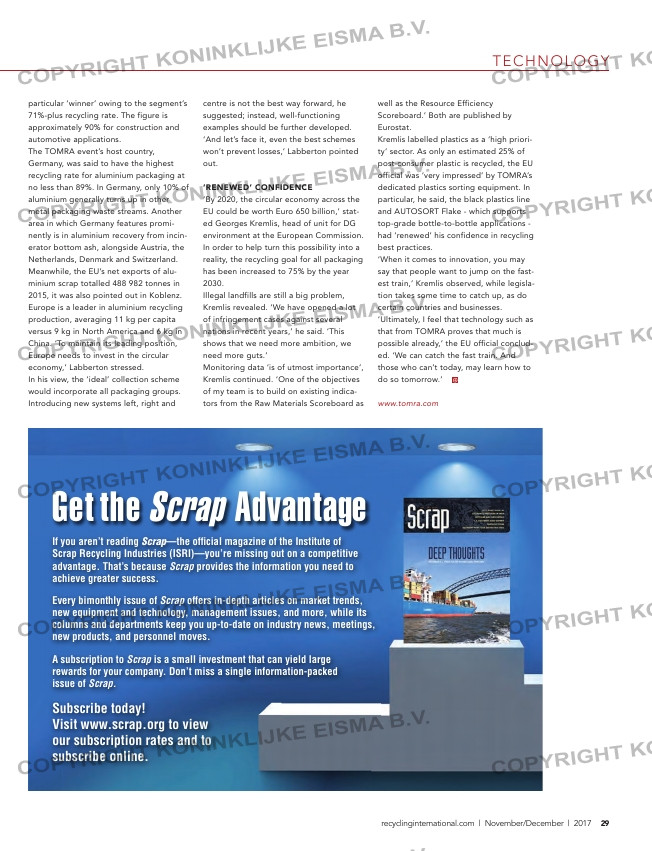Page 29 from: Edition 7 2017

TECHNOLOGY
29recyclinginternational.com | November/December | 2017
particular ‘winner’ owing to the segment’s
71%-plus recycling rate. The figure is
approximately 90% for construction and
automotive applications.
The TOMRA event’s host country,
Germany, was said to have the highest
recycling rate for aluminium packaging at
no less than 89%. In Germany, only 10% of
aluminium generally turns up in other
metal packaging waste streams. Another
area in which Germany features promi-
nently is in aluminium recovery from incin-
erator bottom ash, alongside Austria, the
Netherlands, Denmark and Switzerland.
Meanwhile, the EU’s net exports of alu-
minium scrap totalled 488 982 tonnes in
2015, it was also pointed out in Koblenz.
Europe is a leader in aluminium recycling
production, averaging 11 kg per capita
versus 9 kg in North America and 6 kg in
China. ‘To maintain its leading position,
Europe needs to invest in the circular
economy,’ Labberton stressed.
In his view, the ‘ideal’ collection scheme
would incorporate all packaging groups.
Introducing new systems left, right and
centre is not the best way forward, he
suggested; instead, well-functioning
examples should be further developed.
‘And let’s face it, even the best schemes
won’t prevent losses,’ Labberton pointed
out.
‘reneWed’ confidence
‘By 2020, the circular economy across the
EU could be worth Euro 650 billion,’ stat-
ed Georges Kremlis, head of unit for DG
environment at the European Commission.
In order to help turn this possibility into a
reality, the recycling goal for all packaging
has been increased to 75% by the year
2030.
Illegal landfills are still a big problem,
Kremlis revealed. ‘We have opened a lot
of infringement cases against several
nations in recent years,’ he said. ‘This
shows that we need more ambition, we
need more guts.’
Monitoring data ‘is of utmost importance’,
Kremlis continued. ‘One of the objectives
of my team is to build on existing indica-
tors from the Raw Materials Scoreboard as
well as the Resource Efficiency
Scoreboard.’ Both are published by
Eurostat.
Kremlis labelled plastics as a ‘high priori-
ty’ sector. As only an estimated 25% of
post-consumer plastic is recycled, the EU
official was ‘very impressed’ by TOMRA’s
dedicated plastics sorting equipment. In
particular, he said, the black plastics line
and AUTOSORT Flake – which supports
top-grade bottle-to-bottle applications –
had ‘renewed’ his confidence in recycling
best practices.
‘When it comes to innovation, you may
say that people want to jump on the fast-
est train,’ Kremlis observed, while legisla-
tion takes some time to catch up, as do
certain countries and businesses.
‘Ultimately, I feel that technology such as
that from TOMRA proves that much is
possible already,’ the EU official conclud-
ed. ‘We can catch the fast train. And
those who can’t today, may learn how to
do so tomorrow.’
www.tomra.com
If you aren’t reading Scrap—the official magazine of the Institute of
Scrap Recycling Industries (ISRI)—you’re missing out on a competitive
advantage. That’s because Scrap provides the information you need to
achieve greater success.
Every bimonthly issue of Scrap offers in-depth articles on market trends,
new equipment and technology, management issues, and more, while its
columns and departments keep you up-to-date on industry news, meetings,
new products, and personnel moves.
A subscription to Scrap is a small investment that can yield large
rewards for your company. Don’t miss a single information-packed
issue of Scrap.
Subscribe today!
Visit www.scrap.org to view
our subscription rates and to
subscribe online.
Get the Scrap Advantage
26-27-28-29_tomra.indd 29 20-11-17 16:08



